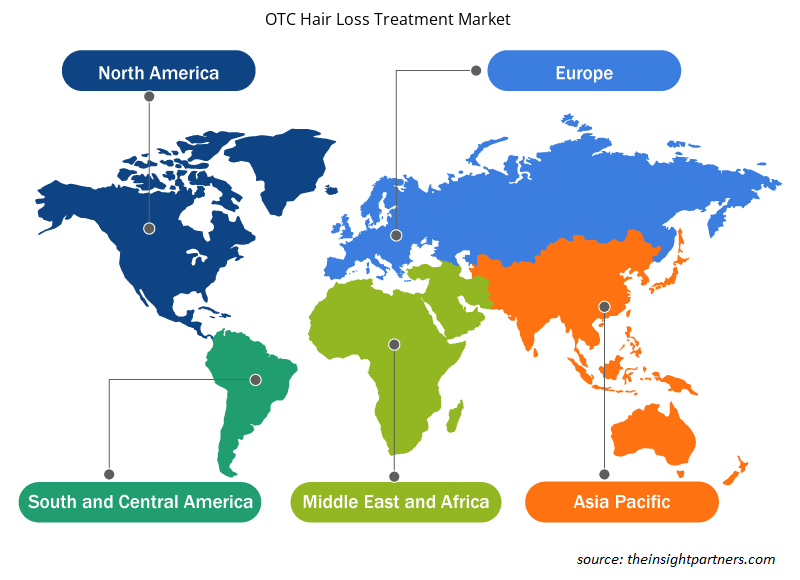OTC 탈모 치료제 시장은 2023년부터 2031년까지 5.5%의 CAGR을 기록할 것으로 예상되며, 시장 규모는 2023년의 XX백만 달러에서 2031년 XX백만 달러로 확대될 것으로 예상됩니다.
보고서는 유형(미녹시딜, 프로카필, 기타)별로 세분화되어 있습니다. 또한 최종 사용(남성, 여성, 기타)을 기준으로 세분화되어 있습니다. 글로벌 분석은 지역 수준과 주요 국가별로 더 세분화되어 있습니다. 보고서는 위의 분석 및 세그먼트에 대한 USD 가치를 제공합니다.
보고서의 목적
The Insight Partners의 OTC 탈모 치료 시장 보고서는 현재 상황과 미래 성장, 주요 추진 요인, 과제 및 기회를 설명하는 것을 목표로 합니다. 이를 통해 다음과 같은 다양한 비즈니스 이해 관계자에게 통찰력을 제공합니다.
- 기술 제공업체/제조업체: 변화하는 시장 역학을 이해하고 잠재적인 성장 기회를 파악하여 정보에 입각한 전략적 결정을 내릴 수 있도록 합니다.
- 투자자: 시장 성장률, 시장 재무 전망, 가치 사슬 전반에 존재하는 기회에 대한 포괄적인 추세 분석을 수행합니다.
- 규제 기관: 시장의 정책과 경찰 활동을 규제하여 남용을 최소화하고, 투자자의 신뢰와 확신을 유지하며, 시장의 성실성과 안정성을 뒷받침합니다.
OTC 탈모 치료제 시장 세분화
유형
- 미녹시딜
- 프로카필
- 기타
최종 사용
- 남성
- 여성
- 기타
귀하의 요구 사항에 맞게 이 보고서를 사용자 정의하세요
이 보고서의 일부 또는 국가 수준 분석, Excel 데이터 팩을 포함하여 모든 보고서에 대한 사용자 정의를 무료로 받을 수 있으며 신생 기업 및 대학을 위한 훌륭한 혜택과 할인 혜택을 이용할 수 있습니다.
- 이 보고서의 주요 시장 동향을 알아보세요.이 무료 샘플에는 시장 동향부터 추정 및 예측까지 다양한 데이터 분석이 포함됩니다.
OTC 탈모 치료제 시장 성장 원동력
- 인식 증가: 탈모와 심리적 영향에 대한 인식이 증가하고 있습니다. 이를 통해 소비자들은 효과적인 일반 의약품 치료를 요구합니다. 소셜 및 소셜 미디어 토론은 이제 탈모 토론을 정상화하는 데 도움이 되었으며, 더 많은 개인이 치료를 받도록 장려합니다.
- 노령 인구: 인구의 상당수가 노인이 되면서 탈모를 경험하는 사용자 수가 증가하는 경향이 있습니다. 이러한 인구학적으로 민감한 현상은 이러한 연령대를 대상으로 하는 일반 의약품 탈모 솔루션에 대한 수요를 증가시킵니다.
- 가처분 소득 증가: 가처분 소득이 증가하면 소비자들이 개인 관리 솔루션에 돈을 쓰는 경우가 늘어납니다. 이는 OTC 탈모 제품 지출을 더욱 늘리고 사람들이 외모와 자신에 대한 관리에 상당한 중요성을 두기 때문에 사업을 성장시키는 데 도움이 됩니다.
OTC 탈모 치료제 시장 미래 동향
- 맞춤형 솔루션: 탈모 치료에 대한 맞춤형 솔루션에 대한 수요가 증가하고 있으며, 소비자들은 자신의 상태를 해결하는 맞춤형 솔루션을 요구합니다. 개인화를 제공하는 브랜드는 사용자에게 더 만족스럽고 효과적인 제품을 만들 수 있습니다.personalization can make the products more satisfactory for users as well as more effective.
- 지속 가능성에 집중: 소비자들은 지속 가능성과 환경 친화적인 접근 방식에 대한 집중이 커지면서 점점 더 주도권을 잡고 있습니다. 환경 친화적인 포장과 성분을 채택하는 브랜드는 소비자의 양심에 어필할 것입니다.
- 기술 통합: 머리카락 건강과 치료 진행 상황을 모니터링하는 앱을 포함한 기술의 발전은 탈모 치료 환경을 변화시키고 있습니다. 이러한 기술은 소비자와 상호 작용하고 적극적인 헤어 케어 접근 방식을 촉진합니다.
OTC 탈모 치료제 시장 기회
- 남성 그루밍 세그먼트: 남성 탈모 치료는 그루밍의 미개척 시장입니다. 이를 통해 남성을 특별히 타겟으로 하는 제품을 만들어 브랜드 가시성과 매출을 늘릴 수 있습니다.
- 제품 혁신: 혁신적인 제형과 전달 방법에 대한 연구 개발에 투자하면 경쟁 시장에서 브랜드를 차별화하는 데 도움이 될 수 있습니다. 독특한 제품은 반드시 주목을 끌고 소비자의 관심을 끌 것입니다.
- 온라인 마케팅 전략: 브랜드 인지도와 참여는 소셜 미디어와 영향력 있는 파트너십을 통해 강화될 수 있습니다. 좋은 온라인 마케팅 전략은 충성도 높은 고객에게 보답함으로써 더 많이 팔리는 제품에 대한 화제를 만들어냅니다.
OTC 탈모 치료제 시장 지역 통찰력
Insight Partners의 분석가들은 예측 기간 동안 OTC 탈모 치료 시장에 영향을 미치는 지역적 추세와 요인을 철저히 설명했습니다. 이 섹션에서는 북미, 유럽, 아시아 태평양, 중동 및 아프리카, 남미 및 중미의 OTC 탈모 치료 시장 세그먼트와 지리에 대해서도 설명합니다.

- OTC 탈모 치료제 시장에 대한 지역별 데이터를 얻으세요
OTC 탈모 치료제 시장 보고서 범위
| 보고서 속성 | 세부 |
|---|---|
| 2023년 시장 규모 | 미화 XX백만 달러 |
| 2031년까지 시장 규모 | 미화 XX 백만 |
| 글로벌 CAGR (2023-2031) | 5.5% |
| 역사적 데이터 | 2021-2022 |
| 예측 기간 | 2024-2031 |
| 다루는 세그먼트 | 유형별로
|
| 포함된 지역 및 국가 | 북아메리카
|
| 시장 선도 기업 및 주요 회사 프로필 |
|
OTC 탈모 치료제 시장 참여자 밀도: 비즈니스 역학에 미치는 영향 이해
OTC 탈모 치료제 시장은 소비자 선호도의 변화, 기술 발전, 제품의 이점에 대한 인식 증가와 같은 요인으로 인해 최종 사용자 수요가 증가함에 따라 빠르게 성장하고 있습니다. 수요가 증가함에 따라 기업은 제품을 확장하고, 소비자의 요구를 충족하기 위해 혁신하고, 새로운 트렌드를 활용하여 시장 성장을 더욱 촉진하고 있습니다.
시장 참여자 밀도는 특정 시장이나 산업 내에서 운영되는 회사나 기업의 분포를 말합니다. 주어진 시장 공간에 얼마나 많은 경쟁자(시장 참여자)가 존재하는지 그 규모나 전체 시장 가치에 비해 나타냅니다.
OTC 탈모 치료제 시장에서 운영되는 주요 회사는 다음과 같습니다.
- 머크
- 존슨앤존슨
- 다이쇼파마
- 코스트코 홀세일
- 월마트
면책 조항 : 위에 나열된 회사는 어떤 특별한 순서에 따라 순위가 매겨지지 않았습니다.

- OTC 탈모 치료제 시장 주요 주요 업체 개요를 알아보세요
주요 판매 포인트
- 종합적 범위: 이 보고서는 OTC 탈모 치료제 시장의 제품, 서비스, 유형, 최종 사용자에 대한 분석을 종합적으로 다루어 전체적인 상황을 제공합니다.
- 전문가 분석: 이 보고서는 업계 전문가와 분석가의 심층적인 이해를 바탕으로 작성되었습니다.
- 최신 정보: 이 보고서는 최신 정보와 데이터 동향을 다루고 있어 비즈니스 관련성을 보장합니다.
- 사용자 정의 옵션: 이 보고서는 특정 고객 요구 사항에 맞게 사용자 정의할 수 있으며 비즈니스 전략에 적합하게 조정할 수 있습니다.
따라서 OTC 탈모 치료제 시장에 대한 연구 보고서는 산업 시나리오와 성장 전망을 디코딩하고 이해하는 길을 선도하는 데 도움이 될 수 있습니다. 몇 가지 타당한 우려가 있을 수 있지만 이 보고서의 전반적인 이점은 단점보다 더 큰 경향이 있습니다.
- 과거 분석(2년), 기준 연도, CAGR을 포함한 예측(7년)
- PEST 및 SWOT 분석
- 시장 규모 가치/거래량 - 글로벌, 지역, 국가
- 산업 및 경쟁 환경
- Excel 데이터세트
최근 보고서
관련 보고서
사용 후기
구매 이유
- 정보에 기반한 의사 결정
- 시장 역학 이해
- 경쟁 분석
- 고객 인사이트
- 시장 예측
- 위험 완화
- 전략 기획
- 투자 타당성 분석
- 신흥 시장 파악
- 마케팅 전략 강화
- 운영 효율성 향상
- 규제 동향에 발맞춰 대응





















 무료 샘플 받기 - OTC 탈모 치료제 시장
무료 샘플 받기 - OTC 탈모 치료제 시장